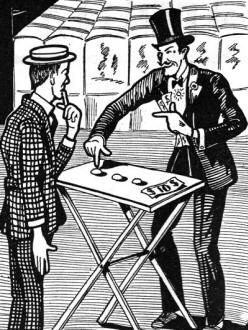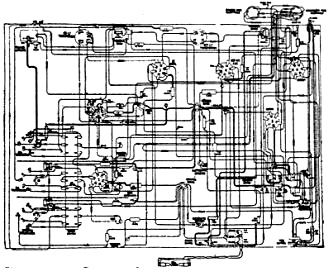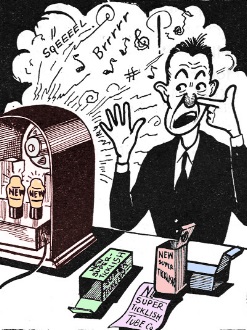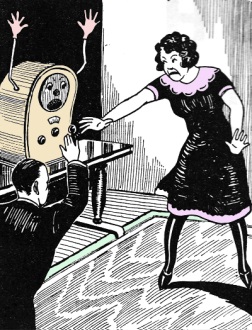Radio Debunked
|
|
This is a true story. When I was in 9th grade, the class was being shown a film (yes, the celluloid type on a reel, on a projector, circa 1972-73) where the narrator mentioned how someone had committed a "boner." A girl in the class busted out laughing so hard that she actually wet herself. That made the rest of the class laugh. I guess she had never heard the word used in that context before - remember, we're talking teenagers in the 1970's. Sorry for the rude reference, but for some reason the incident came to mind when reading the section labeled "Radio Boners" in this article from a 1935 edition of Radio−Craft magazine. Funny what triggers a particular memory. All that has nothing to do with C.W. Palmer's fine story that addresses some of the common misconceptions about the relatively new technology called "radio," when even a term like "speaker" might cause confusion. Radio Debunked
There is an old saying that "every knock is a boost" and it is hoped that our knocks will turn out to be boosts for all concerned. At any rate everyone will agree that radio terms and advertising can stand a "clean up." C. W. Palmer The radio industry, especially that part relating to broadcast reception, is so cluttered up with misconceptions, fallacies, superstitions, etc., that it is high time someone undertook to debunk it. The word "debunk," dear reader, in case you do not know, is a verb used to denote the removal of nonsense or misstatements from anything. So with trepidation as to the landslide which may descend upon our heads from this debunking, let us start upon our self-appointed task. The first thought that comes to mind is the myriad of statements and names in radio which are so far from being exact that they force themselves upon the attention of any clear-thinking reader. Misnomers How many times have you seen the word "loudspeaker" or "speaker" and wondered why a better word could not be chosen? Obviously, it is not a speaker - it reproduces bands and singers as easily as the human voice. ("Reproducer" is a much better term.) And this is only one of many such misnomers. A condenser does not condense anything - it simply stores up an electrical charge. A vacuum tube cannot truthfully be said to be a "tube" as it is not tubular in shape, except in a very few and isolated instances. And no doubt you have heard that wretched expression "A.C. current" which written in full means alternating current current; or, equally as bad, "I.F. frequency" which is intermediate frequency frequency! Or if you have read any of the magazines published across the big pond (in England) you have been amused or perhaps angered by the continuous repetition of the word "wireless." If anything uses more wire than some modern radio receivers, in such a small space, we should like to see it. "Wireless" went out of date, in favor of "radio," "y'ars" ago; (wonder if some folks know the War is over?). Another term which is most aggravating is the use of the word "dry" in connection with the electrical cells used to ring doorbells and heat the filaments of certain vacuum tubes. These chemical cells are far from dry as you can discover by taking one apart (the same fact applies to the "dry" electrolytic condensers). And a single cell does not constitute a "battery", as many writers seem to think - it takes more than one cell to make up a battery. (One prominent battery manufacturer, though, has just introduced a 1 1/2 V. "dry" battery. The term battery is correct in this case as it actually contains 4 cells in parallel. See description in a forthcoming issue of Radio-Craft.) Radio "Boners" One must not take radio terms too literally as this sketch illustrates. You have heard reproducers which are far too "ripe" and more than "half tipsy." Here is what the maker thinks of his set - and just think it's all for $15.00. "What you need is a new set of Super-Ticklish tubes" - the results are just as bad. Everyone will agree that a cleaning up of radio claims would do good. Tone controls (?) do more harm than good - no two people agree on the setting. Along the same line are such words as cat whisker - which neither comes from a cat nor is it a whisker; resistance-coupled amplifier - which is not resistance-coupled but rather condenser-coupled, as the resistors simply place a load on the tube elements and permit the direct potential from the battery or "B" supply to reach the plate without short-circuiting the signal current; static - which is not static electricity at all as students of physics can easily explain, but rather "atmospherics" - that is, natural or man-made high-frequency disturbances. These currents are very much "dynamic" when amplified by a radio receiver! And then, there is the term "oscillating set," as applied to a radio receiver. Obviously the set does not swing back and forth or vibrate, it is the parasitic currents in the set which build up in places where they are not desired that cause the electrical oscillations. Words such as this one are insufficient rather than misnomers and there are quite a few heard frequently in conversations pertaining to radio. For example, "superheterodyne" receiver should be supersonic heterodyne receiver; and "phonograph pickup" is really phonograph-recording pickup. Advertising Misstatements But perhaps, these slips in applying names to radio parts and circuits are much less annoying than the obvious misstatements found in some radio advertisements (some of which make the old "shell game" seem tame). How many times have you heard the word "mellow" linked to radio speaker ads? What on earth has mellowness to do with a device which must transmit sound waves to a listener as nearly identical as possible to the original waves emanating from the instruments? Here is what one dictionary lists to define mellow - "soft and ripe; well matured; soft to the touch, palate, ear, etc.; genial; half tipsy." You have certainly heard reproducers which sounded far too ripe and almost completely tipsy, but that is surely not what the advertisers had in mind when they described their instruments as "mellow." The same false idea is conveyed in describing. the reproducer as a "musical instrument." It is nothing of the sort. Reproducers (loudspeakers, to you!) are required to reproduce music, but they are just as often required to reproduce noises and unpleasant sounds, such as the sound effects used for dramatic presentations. The reproducer of a radio set is no more a musical instrument than is an open window or door through which you hear music. Bologna! And speaking about music, have you noticed the quantities of nonsense in some of the advertisements of vacuum tube manufacturers? "Crystal clear reception with ... s tubes." "His set sounded entirely different as soon as he inserted ... tubes." "What you need is a new set of Super-Ticklish tubes," etc. I do not mean to infer or suggest in any way that all makes of tubes are as good as another - they naturally vary. Occasionally when a new tube is substituted for an old one the quality improves, but this is generally due to the fact that the emission of the old tube has decreased considerably and cannot handle the signals without introducing distortion. Provided you use the right type of tube and one with a suitable impedance, the only difference between various makes (in most circuits at any rate) will be in the strength or perhaps in the life of one make over another. Paging Veracity One of the simplest ways of loosening the aerial coupling to a receiver is to connect a series condenser in the aerial lead-in. It doesn't matter much how you make the small series condenser - it can be the ordinary compression type, a variable air condenser or it can be a metal tube with a terminal at each end, one part of the tube sliding within the other, so varying the capacity. The flights of fancy indulged in with speakers and tubes are nothing compared to the eloquent outbursts which announce some of these aerial condensers. I thought I knew a little about condensers and the effect of placing them in series with the aerial, having used this little kink for a dozen or more years, but those ads certainly taught me a great deal I didn't know before. The Crowning Achievement And talking about eloquent outbursts, the following advertisement was composed, printed and mailed to countless unsuspecting radio set buyers by a supposedly legitimate radio manufacturer: "Steeped in a blaze of glory, adored by millionaire and workman alike, the B. ... Radio with its voice of silver and case of gold is the season's sensation. Built, sponsored, and strictly guaranteed by three organizations with combined plant area of fifty-two acres, aggregate experience of over 100 years in manufacturing and merchandising, it challenges the genius of an entire industry. Its power plant is made up of four huge tubes, the latest multi-mu, screen-grid, power pentode and full-wave rectifier, reinforced by specially designed transformers, condensers, and circuits. Its exclusive Dynamic Speaker, the crowning achievement of sound engineers, has an eloquence so sweet and natural it gives new and unheard-of beauties to tone. Its gorgeous cabinet is a matrix of a $5,000.00 carving from the skilled and talented hand of Everett Worthington, America's foremost product stylist. The standard model shown is done in Studio-Bronze; also others in Antiqued Platinum. The cabinet material, neither wood nor metal, is the latest attainment in tone perfection. Other models, with four or more tubes, made to order at, of course, added cost, come in exquisitely colored aluminum, plated and sterling silver, or even jewel-studded solid gold. In vivid modernized. colors, too, or in the raw. But also an ultra-gift model, its cabinet finish a sleek, rich Black Diamond, encrusted with silver chrome. It is acclaimed the gem of the decorator's art. Specially encased in gift boxes which, when unpacked, transform themselves into handsome paper baskets. The B. ... Radio, distinguished companion of the big expensive radio sets, reposes proudly in the homes and offices of America's business leaders, in the studios of eminent artists and musicians, exclusive clubs and colleges, on pretentious yachts, steamships, and elsewhere in the fashionable places and palaces of the world." - and all this for only $15.00 complete with tubes! Imagine the rhetoric, had the set listed for $25.00! The mere thought staggers our comprehension!! The sooner the radio industry is rid of such practices the better it will be for all concerned - the manufacturer, wholesaler, dealer, buyer and in fact the entire industry. The Inside Facts This leads to the subject of selectivity as claimed by various set advertisers - of course every set is "razor sharp" or has "knife edge" selectivity, but this means as little, as some of the perfect selectivity curves which the writer has been privileged (?) to see. If these curves could be believed, and the manufacturer obviously expects the consumer to believe in their integrity, there can be absolutely no improvement made in radio receivers, at least from the viewpoint of selectivity. Unfortunately, however, these supposed selectivity curves are far from accurate and are quite deceiving to the prospective set buyer. In a group of sets tested by the writer with a laboratory set-up, only 40 per cent came anywhere near to checking with the published selectivity curves and of this number only a mere handful were within 5, per cent of the published curves. Quite a number of sets are now equipped with gadgets which are politely called "tone controls" - the ads being so worded that the prospective buyer is led to believe that by simply turning a knob you can adjust the balance of bass and treble to suit your taste or the acoustic conditions of the room. In a very few cases (those in which more than one control or knob is used) the tone control does actually change the proportion of high-and low-tone output. A great majority of the so-called tone controls, however, are simple devices for removing what high-frequency reproduction there is! Of course, any talk about adjusting the balance of bass and treble to suit the particular music is so much bunk as all modern broadcast stations, especially those in the "hi-fidelity" class send out music correctly and if the receiver is really giving the faithful reproduction claimed for it, we can only spoil this by altering the tone control. The only excuse at all for a tone control, and even here the need, is questionable, is to compensate for high- or low-frequency absorption caused by furniture, drapes, etc., in the room. But I have come to the end of the allotted space and the debunking is only half done, think, though that everyone will agree that a little cleaning up of radio claims would do a lot of good.
Posted October 4, 2016 |
|








